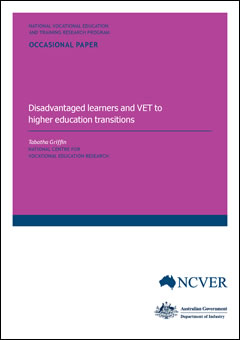Description
How disadvantaged learners participate in VET is an important consideration. Employment and further study outcomes are more likely to result from completing a higher-level VET qualification, but disadvantaged learners tend to enrol in lower-level qualifications. Hence, whether or not disadvantaged learners are transitioning from lower VET qualifications to higher level VET or higher education is of interest. Based on a review of the literature, this paper synthesises what is currently known about these transitions for disadvantaged learners.
Summary
About the research
The vocational education and training (VET) system can provide an entry point to the education sector for people who have experienced disadvantage in their lives. Participation in VET can provide personal benefits as well as lead to further study and/or employment.
How disadvantaged learners participate in vocational education and training is an important consideration. Further study and employment outcomes are more likely to stem from completing a higher-level VET qualification, but disadvantaged learners tend to enrol in lower-level qualifications. Hence, whether or not disadvantaged learners are transitioning from lower-level VET qualifications to higher-level vocational education and training and into higher education is of interest. Based on a review of the literature, this paper synthesises what is currently known about these transitions for disadvantaged learners.
Key messages
Disadvantaged learners tend to be overrepresented in lower-level VET qualifications and underrepresented in higher-level VET and higher education. There is little in the literature that provides student perspectives on transitions from lower-level to higher-level vocational education and training and from VET into higher education. The literature shows that transition from VET to higher education is a viable pathway for some disadvantaged learners, although it is not used as widely as it could be. There are a number of factors that act as barriers:
- Transition from vocational education and training to higher education is more likely to occur from higher-level VET qualifications. However, disadvantaged learners re-engaging with the education sector are more likely to enrol in lower-level qualifications.
- Transition from VET to higher education can be complicated, even for students who are not disadvantaged. This is despite the array of formal arrangements, such as credit transfer, and supports that are in place.
- Support services can make a difference, but there is a tension between providing individually tailored support and system-wide support. Limited resources are an issue, and priority should be given to supports most likely to lead to positive outcomes.
Rod Camm
Managing Director, NCVER
